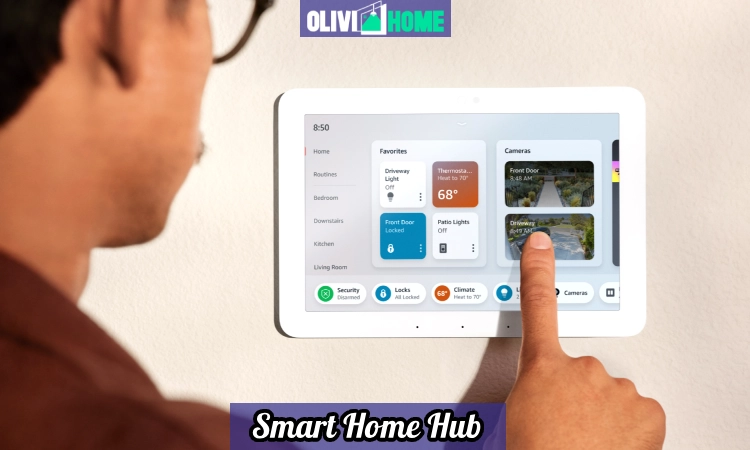Imagine walking into your home, and with a single command, the lights dim, your favorite music starts playing, and the thermostat adjusts to the perfect temperature. This seamless automation is made possible by a smart home hub, the heart of any connected home. In this guide, we’ll explore what a smart home hub is, how it works, its benefits, and whether it’s the right choice for your household.
What Is a Smart Home Hub?
A smart home hub acts as the central control system for all your smart devices. Think of it as the translator between gadgets that speak different “languages.” Many smart devices use protocols like Zigbee, Z-Wave, Bluetooth, or Wi-Fi. Without a hub, these devices might struggle to communicate with one another. For example, if your smart lock uses Zigbee but your smartphone relies on Wi-Fi, the hub bridges this gap seamlessly.
More than just a translator, a smart home hub consolidates control into one platform. Instead of juggling multiple apps for different devices—one for lights, another for locks—you can manage everything through one app or interface. This simplifies your life and makes automation easier than ever before.
Some hubs are standalone devices like Samsung SmartThings or Wink Hub 2. Others are integrated into smart speakers like Amazon Echo or Google Nest Hub. Whether standalone or built-in, these hubs ensure all your devices work together harmoniously.
How Does a Smart Home Hub Work?
Smart home hubs operate as data “traffic controllers.” They gather information from connected devices and send commands based on user input or pre-set automation rules. For instance, you can program your hub to turn on the porch light and unlock the door when you arrive home.
Most hubs use an associated app that serves as a universal remote for all connected devices. Through this app, you can monitor systems like lighting, security cameras, and thermostats from anywhere in the world. The app also allows you to schedule tasks—like having your coffee maker start brewing at 7:00 AM every morning.
The hub’s ability to connect devices across different brands is one of its standout features. For example, if you have smart bulbs from one company and a thermostat from another, the hub ensures they work together smoothly. Without a hub, such integration might not be possible.
Benefits of Using a Smart Home Hub
Centralized Control
One of the biggest advantages of a smart home hub is centralized control. Instead of managing multiple apps for each device, you get one unified platform. This not only saves time but also reduces confusion—especially for families where multiple people need access to smart home controls.
Enhanced Automation
A hub allows for advanced automation that wouldn’t be possible otherwise. For example, you can set up routines where multiple actions occur simultaneously: dimming lights, locking doors, and playing relaxing music at bedtime. These automations make life more convenient while adding an element of luxury to daily routines.
Improved Compatibility
Smart home hubs bridge compatibility gaps between devices using different communication protocols. This ensures that even gadgets from different manufacturers can work together seamlessly. It’s particularly useful if you already own several devices but want them to function as part of an integrated system.
Remote Access
With a smart home hub and its companion app, you can control your devices from anywhere in the world. Forgot to turn off the lights before leaving? No problem—just do it through the app. This feature also adds peace of mind when monitoring security cameras or checking on other systems while away from home.
Challenges and Considerations
While smart home hubs offer numerous benefits, they’re not without challenges.
Cost
Dedicated hubs can be expensive upfront. However, their long-term value often outweighs their initial cost by simplifying device management and enabling advanced automation features.
Learning Curve
For those new to smart home technology, setting up a hub and integrating multiple devices may feel overwhelming at first. Fortunately, most hubs come with user-friendly apps and guides to ease the process.
Dependence on Internet
Many hubs rely on cloud connectivity for remote access and advanced features. If your internet goes down, some functionalities may be limited—though local controls often remain available.
Do You Really Need a Smart Home Hub?
Whether you need a smart home hub depends on your specific setup and goals.
If you only have a few Wi-Fi-enabled devices like smart plugs or bulbs that already work with voice assistants (e.g., Alexa or Google Assistant), you might not need a dedicated hub. However, if you’re planning to expand your system with Zigbee or Z-Wave devices—or want advanced automation—a hub becomes essential.
For tech enthusiasts looking for maximum customization and control over their smart homes, dedicated hubs like Samsung SmartThings or Hubitat Elevation are excellent choices. On the other hand, casual users may find all-in-one solutions like Amazon Echo Plus sufficient for basic needs.
The Future of Smart Home Hubs
As technology evolves, so do smart home hubs. Modern hubs are becoming more versatile by integrating artificial intelligence (AI) and machine learning (ML). These advancements allow hubs to learn user preferences over time and suggest automations tailored to individual lifestyles.
Additionally, new standards like Matter aim to improve device compatibility across brands without requiring proprietary hubs. This could make future hubs even more powerful while simplifying setup processes for users.
Conclusion: Simplify Your Life with a Smart Home Hub
A smart home hub is more than just a gadget—it’s the backbone of any connected household. By centralizing control and enabling seamless communication between devices, it transforms how we interact with our homes.
Whether you’re automating simple tasks or creating complex routines that span multiple rooms and systems, a smart home hub makes it all possible. As we move toward an increasingly connected future, investing in a reliable hub could be one of the smartest decisions for your home.
So why wait? Start exploring options today and take the first step toward building your dream smart home!

